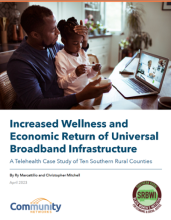By
In a new report, published in partnership with the Southern Rural Black Women’s Initiative (SRBWI), the Institute for Local Self-Reliance (ILSR) Community Broadband Networks Initiative examines the link between high-speed Internet infrastructure, access to healthcare, and the economic implications involved.
The report –“Increased Wellness and Economic Return of Universal Broadband Infrastructure: A Telehealth Case Study of Ten Southern Rural Counties” has particular relevance for those living in rural broadband deserts as it details how universal, affordable, broadband infrastructure would return $43 million per year using telehealth across 10 counties in the Black Belt of Alabama, Georgia, and Mississippi. Read Increased Wellness and Economic Return of Universal Broadband Infrastructure: A Telehealth Case Study of Ten Southern Rural Counties [pdf].
It explains how robust broadband infrastructure could pay for itself in short order and open up untold access to healthcare, educational opportunities, economic development, community engagement, and other benefits along the way. This issue is particularly relevant today, because the BEAD program represents a once-in-a-generation investment in broadband infrastructure, larger than any other federal grant program many times over. While it will solve the issue of access to infrastructure for most rural households, we have significant concerns about affordability - BEAD will lead to new connections, but states have wide latitude as to which ISPs get those funds to build new connections. The national monopolies have a long history of charging more to exactly the communities that can’t pay as much, leaving many households out. The report argues that electric cooperatives offer better and more locally accountable paths to universal, affordable service.
Drawing on academic scholarship and existing telehealth programs at hospitals around the country, the report focuses on an assortment of chronic health ailments plaguing those counties, such as diabetes, chronic respiratory disease (including asthma, chronic obstructive pulmonary disease, emphysema, heart disease, heart failure, cancer, obesity, and mental health and then demonstrates the benefits that could come from effective telehealth interventions for each.



